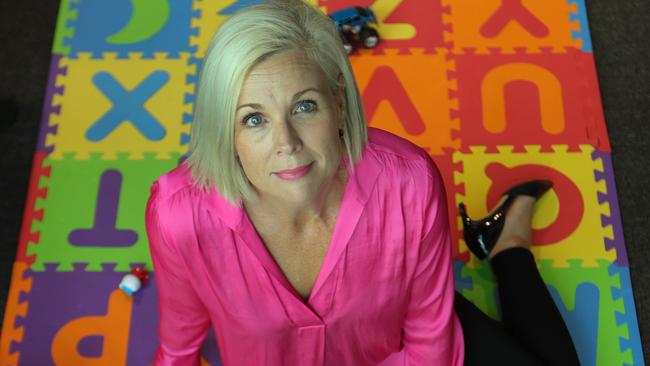IT CAN start simply by being scared of the dark.
A “normal’’ fear for a toddler, parents may happily switch on a night light and, almost overnight, a phobia grows.
Add in the school-age stresses from NAPLAN, homework and social media and we have what is becoming an epidemic of anxiety for students.
Obsessive compulsive disorder (OCD) is now more prevalent among children than autism spectrum disorders (ASD), while 20 per cent of Gold Coast children aged eight to 12 are reporting extreme distress about their appearance — an early warning sign of eating and body dysmorphic disorders.

Griffith University associate professor and clinical psychologist Dr Lara Farrell does not want to freak out parents, but she wants them to know this is a problem that needs our attention.
“There is a very strong biological component to anxiety disorders, but these days we are seeing problems emerge at a much younger age,” says Dr Farrell.
THE INTERVIEW: DR AMANDA MCCULLOUGH
THE INTERVIEW: PTSD SURVIVOR MATTHEW SAWYER
THE INTERVIEW: PROFESSOR IAN O’CONNOR
“It used to be that kids might have a little touch of anxiety or OCD symptoms but they would get through until adulthood and then life stressors would make it very pronounced.
“What we’re seeing now is a much earlier age of onset of these problems, and we believe that is due to the amount of stress that kids are under now.
“OCD alone is a big problem. It’s more prevalent than ASD but less detected. Often, teachers won’t see anything but for families it can really become a living hell.

“The accommodations they make to support a child crippled with fear is just incredible. You could be dealing with anything from kids who take four-hour showers, to buying a second car because the first one is “contaminated”, to kids living in entirely separate dwellings because family members are considered contaminated.
“It can start so subtly and so small that no one realises it until it has become a problem that is then deeply ingrained.”
Dr Farrell pioneered research into the treatment of children with this disorder with the OCD Busters program, which uses state-of-the-art intensive and evidence-based, cognitive-behavioural treatment to achieve “really excellent outcomes’’.
But she believes the key to helping children — and adults — conquer anxiety disorders is to start young.
Dr Farrell’s latest research trial, Pre-Schoolers Overcoming Phobias (POP!), utilises an intensive one-session treatment for young children with specific fears.
“We’re treating children as young as three who are excessively afraid of certain situations or objects such as dogs, the dark, costume characters, high places, water or insects,’’ she says.
“These phobias are highly prevalent and predict a host of mental illnesses later in life.
“It can be really hard for parents to know whether these fears are a problem or something the kids will ‘grow out of’. But we now have data from many trials that show these things don’t go away, they may just present in a different way.
“By treating these children as soon as this mental health disorder first appears, we
hope to prevent a lot of issues later in life.
“Young children are so malleable, it’s a great time to treat problems. It’s also a matter of educating parents. Often when we see our children being fearful, we jump in and rescue them — it could be as simple as turning on the night light — but we’re just facilitating avoidant behaviour. A tendency to avoid rather than approach really predicts long-term anxiety and mental problems.

“What we’ve been discovering so far is that when we treat one phobia, all the others go away as well. These children are developing tools to be resilient and brave and are mastering the skills to face fears. Our hope is that it will help them successfully handle anxiety throughout their life.”
OTHER NEWS:
Tattoo shop firebombed as bikie violence escalates
Rural dump sells just shy of $1m
‘Harmful cult’ behind Coast clinic
Dr Farrell says children of all ages and abilities are affected by anxiety.
She is part of a team, led by Professor Allison Waters, working in partnership with the National Rugby League to improve the mental health of young Australians in sport through the Life Fit program.
“We’re really working to identify mental health issues with kids who are involved in an elite level of sport,” Dr Farrell says.
“These adolescents are under huge pressure and often don’t have the skills they need to handle it, like grit and perseverance.
“It’s great to see a body like the NRL take this well-rounded approach. If we don’t help these players at this age, it can turn into the problems you read about it in the media when they are adults — alcohol and drug issues, gambling, relationship problems, and so on.
“We’re combining on-field tactics with life tactics.”
Dr Farrell is also fighting for funding to study body dysmorphic disorder (BDD),
a problem she believes is growing.
She says her colleague, Professor Melanie Zimmer-Gembeck, has been tracking students with Body dysmorphic disorder (BDD) symptoms.
The results are disturbing.
BDD has a high suicide rate.
“BDD is a lesser known mental illness. It’s thought that about 2 per cent of the population has it but, like OCD, it is a very secretive disorder.
“What we’re trying to do at the moment is understand the presentation of BDD and work with schools in a longitudinal study to track kids who report symptoms.
“We’re looking at children aged eight to 12 and we’re seeing more than 20 per cent reporting severe distress about their appearance.
SUBSCRIBE TO THE GOLD COAST BULLETIN — JUST $1 FOR THE FIRST 28 DAYS
“That’s not clinical BDD but that is a very large proportion of young children with BDD concerns. It’s very worrying. Our study will track what happens to them.
“A small subset may develop BDD but it’s likely many will develop mental health issues such as depression and eating disorders. This is a problem that is equally affecting boys and girls.
“We’re trying to get more funding so we can really look into how to help these children. What are the risk factors? My suspicion is that social media and filters and selfies are not helping. But also, what can we do to treat them?
“The current treatment for adults is not very effective. Only half show good responses. We want to research treatments that will work on young people. It comes down again to resilience, understanding their emotions and dealing with anxiety.”
Dr Farrell says some of her successful anxiety treatment breakthroughs have been hampered by a lack of accessibility due to the structure of Medicare.
She says her research shows intensive treatments are proving far more effective than the traditional one-hour per week sessions covered by the Government’s medical benefits scheme.
“I’m not quite sure who came up with the idea that one hour once a week is the way to treat mental health issues,” she says.
“It seems far more effective, according to our research, to do intensive sessions. That may be a one-session three-hour treatment or three intensive sessions.
“The problem is that Medicare will only cover one hour a week for 10 weeks. The result is that for a lot of families, the cost is too much.
SUBSCRIBE TO THE GOLD COAST BULLETIN — JUST $1 FOR THE FIRST 28 DAYS
“It’s such a shame to know that we have evidence-based treatments that are really working but not be able to help everyone who needs it.”
Dr Farrell says while her methods are clinical, her deep empathy for her subjects comes from being a mother.
She sympathises with parents who struggle with stress themselves and endeavour not to infect their families with the same anxiety.
“It’s hard. I get it,” she says.
“As parents we’re dealing with stress from work, the stress of finances, the stress of dealing with the demands of technology, homework and sport or extra-curricular activities on our kids. It’s hard not to be affected.
“The best thing you can do is encourage your children to talk to you. Don’t let them avoid problems by burying their head in an iPad, or you in your phone. And try not to give in to the stress.”
* If you are interested in your child taking part in the free Pre-Schoolers Overcoming Phobias (POP!) program, please visit www.griffith.edu.au/kids-overcoming-phobias


Add your comment to this story
To join the conversation, please log in. Don't have an account? Register
Join the conversation, you are commenting as Logout
Sharks unveil huge new stadium, $500m mega development
Southport Sharks has unveiled plans for a near-21,000-seat stadium and three residential towers in a massive redevelopment that could reshape the Gold Coast's sporting landscape.
Revealed: All Coast’s options for solving gridlock nightmare
The Gold Coast's population will surge by 350,000 in two decades, but the city's transport blueprint remains in limbo after light rail's dramatic cancellation. FIND OUT MORE